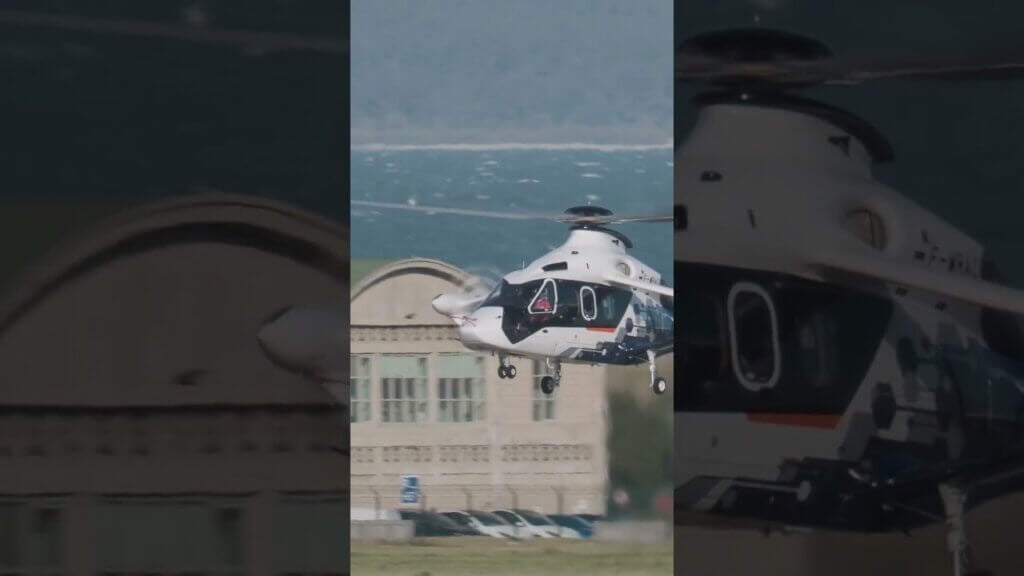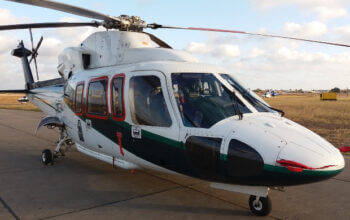
On a clear, windy day in early December, a small crowd gathered at AgustaWestlands facilities in Arlington, Texas, to witness a demonstration flight by an AW189 the second of five prototypes now flying in the AW189 certification program.
The flight lasted only about 10 minutes, but it was impressive. From precise hovering maneuvers to aggressive accelerations and hammerhead turns, the demonstration was clearly intended to convey AgustaWestlands confidence in its new, eight-tonne helicopter design. The ensuing press conference was about confidence, too confidence that the AW189 will achieve certification in 2013, and that it will compete favorably in the increasingly crowded offshore helicopter market.
Its a significant investment by AgustaWestland to put five prototypes out there for certification, said Michael Bucari, a market analyst with AgustaWestland. Along with the concurrent development of the 4.5-tonne AW169 helicopter and the AW609 tiltrotor, he said, it shows a significant amount of trust by AgustaWestland management.
The AW189 has made steady progress toward certification since it was first announced at the Paris Air Show in June 2011. The first prototype made its maiden flight in December 2011, ahead of schedule. Additional prototypes joined the program throughout 2012, with the fifth prototype conducting its maiden flight on Nov. 30. Collectively, the five aircraft have now logged more than 800 flight hours. AgustaWestland is projecting European Aviation Safety Agency certification in the second half of 2013, with United States Federal Aviation Administration (FAA) certification to follow close behind.
Although AgustaWestland sees a number of potential applications for the AW189 including VIP transportation and parapublic operations the sectors most squarely in its sights are search and rescue, and offshore oil and gas, with the latter being the main focus of the companys efforts. Like other helicopters in development, namely the Eurocopter EC175 and the Bell 525 Relentless, the AW189 is intended to fill a niche in the offshore market between intermediate helicopters such as the AW139, and heavy helicopters including the Eurocopter EC225 and Sikorsky S-92. This new class of helicopters has the range required to reach deepwater platforms and drilling rigs, but at a more economical cost than the largest helicopters. Its a cost-effective, more efficient way of moving passengers, said Bucari. This is the only aircraft that can put 12 pax in there and go out to 200 nautical miles.
According to AgustaWestland, in a typical offshore configuration, the AW189 will be able to transport 12 passengers to a radius of 200 nautical miles, 16 passengers to a radius of 140 nautical miles and 18 passengers to a radius of 110 nautical miles, including full return fuel plus 10 percent reserves. If the AW189 achieves these numbers, it will have a slight performance edge over the EC175 (last year, Eurocopter announced that the EC175 would be able to carry 12 passengers to 190 nautical miles and 16 passengers to 135 nautical miles, plus plans for an 18-passenger option that would have a radius of action of 100 nautical miles). Although AgustaWestland has yet to name a price for the AW189, the company is promising that the aircraft will be very competitive for its size.
Also likely to appeal to the safety-conscious offshore sector is the AW189s compliance with the 7/7=1 helicopter risk reduction program, which aims at reducing the accident rate for offshore helicopter operations. Aspects of the program include compliance with the latest amendments of Certification Specifications/Federal Aviation Regulations Part 29; ability to meet the requirements of Performance Class 1 or enhanced Performance Class 2; and the use of safety equipment including health and usage monitoring systems (HUMS), traffic collision avoidance systems (TCAS), enhanced ground proximity warning systems (EGPWS) and helicopter flight data monitoring (HFDM). The program also advocates the use of full-flight simulators (FFS) for training; a Level D FFS for the AW189 is in development.
Why the focus on oil and gas? We believe, because of . . . the way deep oil is going, its only going to be a product market thats going to expand, said Bucari. Launch customers for the AW189 include offshore operators Bristow Helicopters, Gulf Helicopters, Era Helicopters, Bel Air, Weststar Aviation Services and Azerbaijan Airlines.
AgustaWestland currently has more than 60 firm orders and options for the AW189, and is projecting opportunities for around 600 aircraft over a 20-year product lifespan. This is a relatively conservative estimate given the success of the AW139, which was introduced in 2003 and how has a global fleet of more than 500. Although the AW189 is not a derivative of the AW139, it is closely related: along with the smaller AW169 that is also in development, all three aircraft share a common cockpit layout, design philosophy and maintenance/training concepts as part of AgustaWestlands family concept. Bucari said that AgustaWestland has also applied lessons learned from the AW139 to the AW189: A lot of what weve done on the 139 weve taken and improved for the 189, he said.
Thus far, the AW189s flight testing program appears to have been progressing relatively smoothly. In a new approach for the company, much of that testing has taken place in the United States: of the programs 800-plus accumulated flight hours, more than 160 have been flown in the U.S. The second prototype arrived in the U.S. in July 2012 for a nine-month flight testing campaign that began with airfield performance and hot-and-high testing in Texas and Arizona. After its demonstration in Arlington in December, it headed north for several months of cold-weather testing in Alaska.
The AW189s U.S. testing phase both takes advantage of and reinforces AgustaWestlands sizable investment at the Arlington Municipal Airport, where the company is pursuing U.S. FAA certification of the AW609 program that it wholly acquired from Bell Helicopter in 2011. Although certification of the civilian tilt-rotor is further down the road AgustaWestland is now targeting 2016 for AW609 certification the company claims to be making significant progress with that program, too. Since buying Bells stake in the project, said AW609 marketing head Richard Luck, weve invested a significant amount of money in building up the resource base to get the program moving at the pace we want to see it moving. The first AW609 prototype is currently flying in Arlington; the second prototype is flying in Cascina Costa, Italy; and two additional prototypes are currently under construction.
The AW189 and the AW609 will both be entering tough markets: the former, a market that is crowded with competitors; the latter, a market that doesnt yet exist. AgustaWestland is betting that it has the confidence and commitment to succeed in both. Time, of course, will tell.








